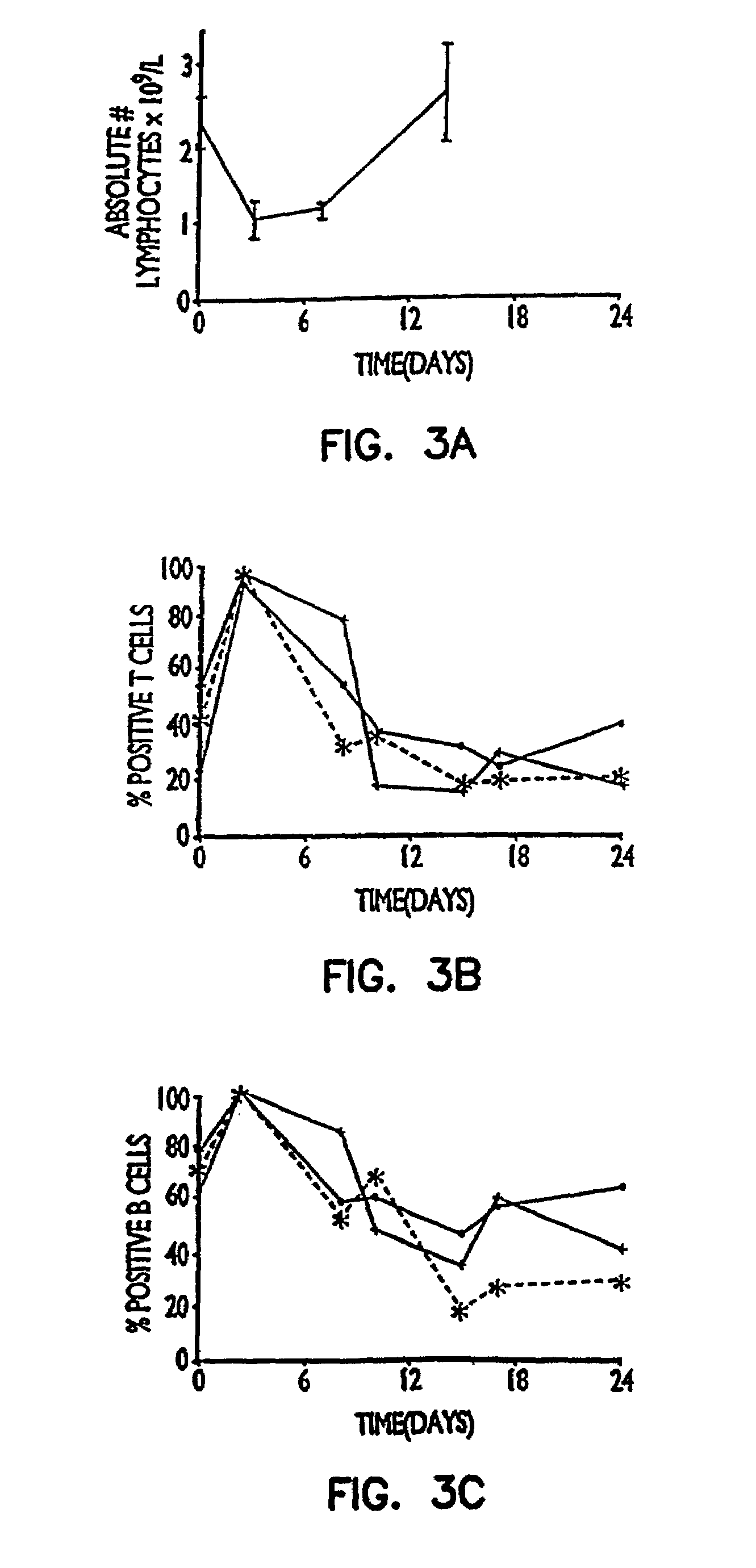Use of anti-CD45 leukocyte antigen antibodies for immunomodulation
an anti-cd45 and leukocyte technology, applied in the field of immunomodulation using anticd45 leukocyte antigen antibodies, can solve the problems of increasing the number of complications of immunosuppressant drugs, and the recipients can become very susceptible to infection, so as to inhibit the expression of inflammatory cytokines, induce tolerance, and increase the tyrosine phosphorylation of (plc-1)
- Summary
- Abstract
- Description
- Claims
- Application Information
AI Technical Summary
Benefits of technology
Problems solved by technology
Method used
Image
Examples
example 1
Murine Monoclonal Antibody to CD45RB
[0067]Murine monoclonal antibody to human CD45RB is produced by using conventional techniques, essentially as described by Kohler and Milstein in Nature 256: 49. Female BALB / C mice (20–25 g) each receive 100 μg of antigen containing human CD45RB, e.g., Hodgkin cell line DEV (publicly available), by i.p. injection. (Alternatively, the antigen may comprise murine cells which have been transformed to express human CD45RB). After 2 weeks a second booster injection comprising 50 μg of the antigen is administered, again by i.p. injection. The presence of antibodies reactive to the antigen in the animals' blood serum is confirmed by immunohistologic screening. Mice displaying maximum blood serum levels of CD45RB antibody receive another booster injection comprising 20 μg of antigen. Four days later, they are sacrificed and their spleen cells are isolated and fused with a suitable myeloma line, e.g., myeloma X63 (publicly available). The resulting hybrido...
example 2
Chimeric Monoclonal Antibody to CD45RB
[0072]a) Cloning of the Gene Encoding the Variable Domain of the Heavy Chain
[0073]The genomic DNA of the desired hybridoma, in this example the MT3 or 6G3 hybridomas of Example 1, and of the parental myeloma cell lines of the hybridomas (myeloma X63 or SP2 / O) is isolated and digested with EcoRI. Each digested DNA is then fractionated on the same agarose gel. After migration, the agarose gel is analyzed by Southern blot using as probe a 32P labeled 0.7 kb XbaI-EcoRI DNA fragment which encodes the murine heavy chain enhancer Eμ (Heinrich et al, J. OF IMMUNOL. (1989) 143: 3589) to identify the desired variable heavy chain fragment, i.e., the desired fragment is present in the MT3 and 6G3 hybridomas but not in the X63 or SP2 / O myelomas. Further purification of this fragment is then carried out by preparative agarose gel electrophoresis.
[0074]DNA fragments of the same size as the desired fragment are cloned in the EcoRI restriction site of bacterioph...
example 3
In vivo Prevention of Rejection of Kidney Transplants in Mice
[0092]In this experiment a right nephrectomy was performed on 18 mice at the same time an allograft (kidney transplant from a different strain of mouse) was performed. A contralateral nephrectomy was followed on the seventh postoperative day (POD 7), so that from that point on, the animals relied only on the allografted kidney. Nine of the mice were treated with 50 μg of a mixture of rat anti-mouse CD45RB monoclonal antibodies produced from cell lines HB220 and HB223 iv for the first two days (POD 0 and POD 1) followed by 100 μg of each antibody intraperitoneally (i.p.) for 9 days (POD 2 to POD 10). Of the nine control animals which did not receive the anti-CD45RB antibodies, seven were dead three days after the second kidney was removed, and the remaining two exhibited severe rejection one week later.
[0093]Of the nine animals treated with the anti-CD45RB antibodies, there were three deaths due to surgical complications un...
PUM
| Property | Measurement | Unit |
|---|---|---|
| Mass | aaaaa | aaaaa |
| Molar density | aaaaa | aaaaa |
| Fraction | aaaaa | aaaaa |
Abstract
Description
Claims
Application Information
 Login to View More
Login to View More - R&D
- Intellectual Property
- Life Sciences
- Materials
- Tech Scout
- Unparalleled Data Quality
- Higher Quality Content
- 60% Fewer Hallucinations
Browse by: Latest US Patents, China's latest patents, Technical Efficacy Thesaurus, Application Domain, Technology Topic, Popular Technical Reports.
© 2025 PatSnap. All rights reserved.Legal|Privacy policy|Modern Slavery Act Transparency Statement|Sitemap|About US| Contact US: help@patsnap.com



